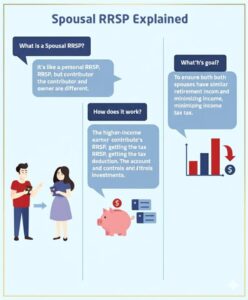
RRSPs for Your Spouse in Canada Maximize Tax and Retirement Benefits
RRSPs for Your Spouse in Canada is an effective retirement planning tool that couples use to save. Couples will be able to minimize the taxable income by contributing to a spouse RRSP, divide retirement
income, and increase the likelihood of saving more tax. This guide mentions the contribution rules, the timing of withdrawal, the attribution rules, and the benefits of estate planning. RRSP spousal contribution limits can also be compared by the readers and RRSP quotes can be obtained online to make decisions that can be made towards their financial future.
Introduction
You can find that whether you are 3 years or 30 years old, retirement planning as a couple never goes to waste, the sooner you plan your income plan, the more favourable.
Consider the following case: one of you makes much more money than the other. Then, suddenly long-term factors such as taxes, withdrawals, and government benefits begin to have a bearing. Having all your savings in a single name may not be the best decision to make.
This is where a Spousal RRSP will come in with massive difference. It is surprising that it is one of the least-utilized couple tools in Canada. All too frequently, one of the spouses ends up earning most of the money and the other has little or no RRSP savings of their own- resulting in a greater tax liability than is required. Spousal RRSPs help even this score, lessen tax payments and position one or the other partner better at retirement.
But there’s a better way to plan.
A Simple Definition That Goes a Long Way
A Spousal RRSP is not very different to a personal RRSP- except on one important aspect, the contributor and the owner are not the same.
In Canada, when you are the higher earning earner, you make contributions to a Registered Retirement Savings Plan (RRSP) for your spouse in Canada. The account is owned by your spouse or common-law partner and she makes the investment decisions, yet you receive the tax deduction on your contribution.
Imagine dividing the income prior to the onset of retirement. The ultimate goal? To make sure the two spouses retire earning the same amount of income so that one spouse does not pay higher taxes than he or she should. The advantage of using RRSPs for your spouse in Canada is that this can be a brilliant, strategic move that will provide the best tax savings and develop a balanced retirement between the two spouses.
Let’s Talk Strategy Not Just Saving, But Planning
What a lot of them do not know is that you do not have to be close to retirement before you can open a Spousal RRSP. You only need earned income and contribution room–that is all.
You can contribute:
- During your full-time employment.
- As your spouse is at home bringing up children.
- When they are in between jobs or have part time jobs.
- Until you reach 71 and still have room to contribute to your RRSP, even after you are 71 as long as your spouse is under 71.
It is not unusual to find couples in which one of the partners has a six-figure salary and the other has a much lower one. The more affluent spouse will tend to take out sizeable sums during retirement without thinking, which will propel him or her into a higher tax bracket and will be losing money.
RRSPs allow the lower-income spouse to draw out of his own RRSP during retirement at a lower tax rate, in Canada, and by using RRSPs on behalf of your spouse, you can maximize tax efficiency and create a more intelligent retirement structure.
That’s real-life tax savings. Not just theory.
Contribution Rules You Can’t Afford to Ignore
Let’s keep it simple. In Canada, when you are using Spousal RRSP or RRSPs on your spouse, you must know about:
- The total of your RRSP contributions is that of your spouse.
- By 2025, this will be 18 percent of your earned income to a maximum of 32,490.
- There is still any unused contribution room of the past years.
- Make sure that you look at your CRA Notice of Assessment to determine the exact room in which you make your RRSP contribution.
The trick of it is here, here, in that, by giving too much, penalties are caused. Regardless of whether you are contributing to your own RRSP, a plan based on your spouse, or a plan in your Group RRSP at work, contributions are aggregated- you do not receive separate quotas. Careful planning will make sure that you do not overstep your boundaries and can reap maximum out of RRSPs for Your Spouse in Canada.
That’s something we guide our clients through step-by-step.
The Attribution Rule: Don’t Let It Surprise You
It is among the regulations that lead to the downfall of the more couples than it should. This is a trap to consider when you make a contribution to a Spousal RRSP or RRSPs that are making on behalf of your spouse in Canada: in that case you spouse is allowed to withdraw funds within three calendar years of your last contribution, the Canada Revenue Agency (CRA) can choose to have the tax charged against you, not your spouse.
This is referred to as the rule of three-year attribution.
Our advice? In order to get a tax saving, it is important to ensure that there are no withdrawals within the first three full calendar years of the last time you made a contribution. Otherwise, you will just be taxed on the income of the higher income earner rather than utilizing the lower taxable income of your spouse.
Real Numbers, Real Results
Here’s a classic scenario.
- Spouse A earns $110,000/year.
- Spouse B earns $35,000/year.
- They want to withdraw $70,000/year during retirement.
Now without a spousal RRSP?
- Spouse A takes the full $70,000.
- They get bumped into a higher tax bracket.
- They pay more than necessary.
With a spousal RRSP in place?
- Spouse A and B each withdraw $35,000.
- Both stay in lower-income brackets.
- Each benefit from the basic personal amount (which is $15,705 in 2024).
- The result? They keep more of their money.
Just that one adjustment alone can amount to thousands saved every year. Add that up over 25 years of retirement? That’s real wealth preservation.
What If You Both Already Have RRSPs?
To take a practical case of the difference that RRSPs as spouse in Canada could make:
- Spouse A earns $110,000/year
- Spouse B earns $35,000/year
- Their retirement will be an amount of $70,000/year.
Without a Spousal RRSP:
- Spouse A withdraws the full $70,000
- They are pushed to the superior tax bracket.
- The net effect is that they are paying higher than they should.
With a Spousal RRSP in place:
- Spouse A and B each withdraw $35,000
- They both remain in the low-income groups.
- The basic personal amount (or 15 705 in 2024) is beneficial to each.
- The result? They keep more of their money
Those single changes will be able to save thousands annually. That is many years of wealth saving during retirement of over 25 years.
And What About Common-Law Couples?
Good news! The CRA regards you as common-law of you have lived together with your partner after 12 months in a conjugal relationship. It implies that you can exploit all the rules of spousal RRSP Canada provides. In Canada, you do not have to be in a marriage union with your spouse to have the advantage of income splitting and tax saving using RRSPs on behalf of your spouse.
Separation and Spousal RRSP: What Do You Know?
This may become tricky; however, the following is a clear breakdown:
- RRSPs are also included in family assets in a divorce, such as spousal RRSPs.
- In the majority of provinces, RRSPs accumulated in the course of the relationship are divided in half.
- Court order or written agreement may be used to transfer RRSPs tax free between one spouse to another.
- Tax-deferred transfers at separation can be done but only in the right way. One should never transfer RRSP funds without consulting an accountant or law firm during a partition.

Why Couples Choose Canadian LIC
At Canadian LIC, we don’t just set up RRSP accounts we take a holistic approach to retirement planning for couples in Canada. We carefully look at your:
- Current income and projected earnings
- Existing RRSP accounts and unused contribution room
- Age differences and retirement timelines
- Personal goals and lifestyle expectations
Once we understand your full financial picture, we provide practical strategies. That includes guidance on when to contribute and withdraw, how to avoid retroactive taxes, and how to combine spousal RRSPs with other smart tools like Registered Retirement Income Funds (RRIFs), corporate insurance plans, estate planning, and even Supervisa Insurance for families planning visits from abroad.
Our team helps couples maximize tax savings, balance retirement income, and build a secure financial future together. We’ve assisted clients in:
- Recovering overpaid taxes
- Protecting pension income
- Optimizing income splitting
Retiring with confidence, knowing their investments, RRSPs, and insurance coverage are strategically structured
When you work with Canadian LIC, it’s not just about contributing to an RRSP—it’s about creating a comprehensive, tax-efficient retirement plan that grows and adapts with your life while keeping your family protected with options like Supervisa Insurance.
Final Thought
If you earn more than your spouse and are planning to retire together, don’t underestimate the benefits of a Spousal RRSP. Starting early gives you more flexibility, greater control over your retirement income, and the chance to maximize tax savings over the long term.
RRSP rules might seem confusing at first contribution limits, attribution rules, and withdrawal timing all play a role but with the right guidance, they can work in your Favor. By contributing strategically to a Spousal RRSP or using RRSPs for your spouse in Canada, couples can balance retirement income, reduce tax burdens, and secure financial stability for both partners. We also assist families organizing international trips by integrating Supervisa Insurance, which guarantees your loved ones’ safety while in Canada and gives your family peace of mind in addition to financial stability.
Retirement planning is more than just saving it’s about building a smart, long-term strategy that safeguards your lifestyle, grows your wealth, and gives both partners peace of mind. The earlier you begin, the more time your investments have to grow, the more opportunities for income splitting, and the greater your confidence in a comfortable, tax-efficient retirement.

 647-640-2222
647-640-2222